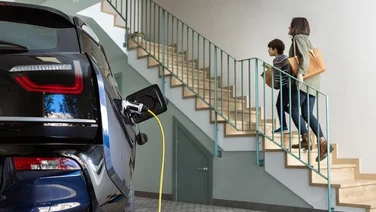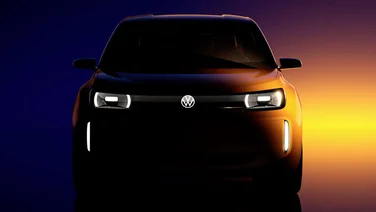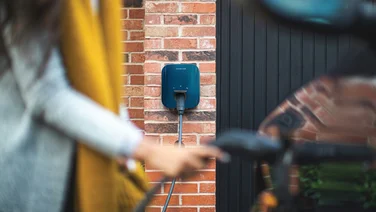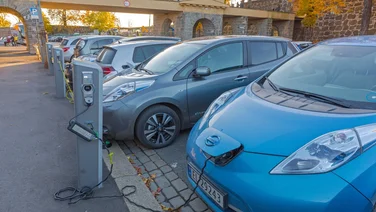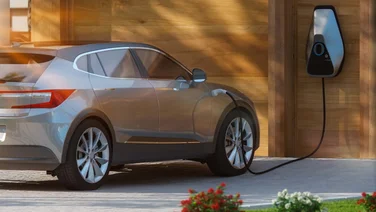- These EV myths can be a barrier to adoption
- According to a report by BYD, 18% of 2,000 respondents believed you can’t take it with you when you move house
- The only way to tow an EV is with a flatbed tow truck
Electric vehicles (EVs) are booming in popularity, with more than 1.5 million battery-electric cars and more than 843,000 plug-in hybrid vehicles registered, as of May 2025.
Unfortunately, there’s still some common misconceptions around electric vehicles (EV), which can swiftly become a barrier to adoption.
These include:
- Not being able to take an EV charger with you
- That an EV can be manual
- EVs can’t drive through water
- They won’t last as long as their petrol or diesel counterparts
- EVs can charge themselves
- EVs can’t be towed
While it’s easy to see why someone might believe this, they are in fact, myths – and we’re here to tell you why.
Myth #1 – You can’t take an EV charger when you move house
According to a report by EV giant BYD, 18% of 2,000 respondents believed you can’t take it with you when you move house.
While, It’s easy to believe that once an EV charger has been installed that it can’t be removed, that is actually a myth. Nonetheless, it’s a commonly believed myth.
You can have it professionally uninstalled and reinstalled at your new address, and is quite a straightforward process. It’s best to budget this into your moving costs, so you’re prepared. It’s also wise to reach out to your original installer to carry out the job, too.
Installer Smart Home Charge says that while the cabling that enables the EV charging point will be left behind, any vendor will ensure the cables are safe before you move. They add that you will likely need to re-do a site survey on your new home prior to moving to ensure it’s suitable for an EV charger.
Its website says that the only event an EV charger won’t be removed is if the unit itself is damaged. “This would be the only situation where it couldn’t be used for a new installation,” Smart Home Charge states. “Even if the charging unit was damaged, a Smart Home Charge installer would still be able to uninstall and make everything safe and secure.”

Myth #2 – EVs are manual
EVs are “automatic by design”, according to Steve Beattie, sales and marketing director, BYD UK, citing their. “consistent power delivery” which removes the need for a clutch or gearbox. “They’re [EVs] built for simplicity and efficiency, making them easier and smoother to drive.”
The consistent power delivery is also known as a torque, which an EV will deliver, regardless of rotation speed. Although many drivers are not used to driving an automatic car – whether an EV, petrol or diesel – you can change the way your car responds and drives with driving modes, according to EV manufacturer DS Automobiles.
The benefits of driving are automatic are plenty, though:
- They’re easier to drive: With no clutch or gears to worry about, driving an EV becomes much easier than the manual car you’re used to driving. This can also be beneficial for people with a disability or limited mobility.
- Cheaper maintenance costs: EVs have far fewer moving parts, meaning there’s less to fix if something goes wrong. What’s more, with no clutch or gearbox, they’re significantly cheaper to fix.
- Instant power: EVs can accelerate much quicker than petrol or diesel manual cars because you don’t need to worry about increasing gears to get the revs up. Thus, power is delivered seamlessly for instant power.
- Increased efficiency: You don’t need to worry about seamlessly changing gears and if you’re in traffic, you won’t need to worry about clutch control – because there isn’t one. DS Automobile adds that every time you stop and start, this turns kinetic energy into electricity (regenerative braking), which is used to charge your battery and improve efficiency.
Myth #3 – EVs can’t drive through water
It’s easy to see why people believe EVs can’t drive through water, they’re electric after all, which doesn’t mix well with water. It’s commonly believed, too, with one in six thinking this.
However, Beattie commented that modern EVsbuilt to “rigorous safety standards”, with waterproofed components that allow them to drive through water just as safely as petrol or diesel cars.
“Whether it’s rain, puddles, or car washes, EVs are thoroughly tested for water resistance, so drivers don’t need to worry,” he said.
The lithium-ion batteries in EVs have an additional shield around it to protect it from water and is electrically isolated and EVs are designed to even keep you safe in the event of a lightning strike. The outer metallic frame is designed to redirect the current away from the interior of the car and into the ground.
These protections also mean your EV is absolutely safe to go through a carwash.
However, don’t try to drive through a flood because doing so can damage your engine, which can be costly to fix. If you’re unsure, the AA recommends you should never drive into flood water that’s moving, or deeper than 10cm and the Environment Agency says driving through 30cm of flowing water can move a car off course.
Myth #4 – EVs won’t last as long as a petrol car
The average lifespan for a petrol car is around 11-14 years or 200,000 miles, providing it’s well-maintained, similar to an EV. However, as technology continues to advance, specifically for batteries, this could change quickly.
What’s more, as an EV has less parts for it to handle, this can reduce wear and tear over time. Beattie says when buying an EV to look out long warranties, as this can highlight an EVs durability and reflect manufacturers’ confidence in their longevity.
But you might be asking yourself, what contributes to EV longevity and how you can improve it?
According to Ontario Auto Centre, you can take the following steps, which can help:
- Mind the temperature: Extreme heat or cold can accelerate battery degradation, so parking in garages or shaded areas can help maintain the health of your battery. Most EVs have battery management systems, though, so double check when buying.
- Optimise charge levels: Similar to how you won’t let your petrol or diesel car run on empty because it can do more harm than good, it’s best to not let your EV charge get too low. Keeping your battery charged between 20-80% is widely recommended to prevent strain on your battery.
- Fewer moving parts: As we’ve already mentioned, EVs have fewer moving parts, with no need for oil changing, belt changes or exhaust system repairs. This results in fewer breakdowns and potentially longer life for your EV.

Myth #5 – EVs can charge themselves
Unfortunately, like petrol and diesel cars, EVs need ‘fuel’ to drive, it just happens to be electricity.
As of May 2025, there were 80,998 EV charging points across the UK at 39,773 charging locations, according to Zap Map. This means every few miles, there will be an EV charging point.
There are four speeds or power ratings you can choose from, depending on how fast you want to charge your EV for. These are slow (3-7kW), fast (8-49kW), rapid (50-149kW) and ultra-rapid (150kW+).
But for convenience, you might want to consider installing a charge point at home. Compared to charging in public, you could cut recharging costs by £467 per year. You can also get some chargers that will only charge your car at times when electricity is cheapest (off-peak), too.
A charger costs around £1,000, on average, but find out more from our guide: Electric car charger installation costs in the UK.
Myth #6 – EVs can’t be towed
Eleven per cent of 2,000 respondents from BYD’s latest report believe EVs can’t be towed, but they absolutely can, if the correct method is used.
Unlike a petrol or diesel car, an EV would need to be in drive or reverse to be towed, which may engage the electric motor and can cause serious damage to the battery and motor. Therefore, ATS Euromaster says towing an EV with a standard towing setup is virtually impossible.
The only way to tow an EV is with a flatbed tow truck, as this usually carries other vehicles on its body. The truck is lowered or titled to load the car or by winching the car aboard, letting EV drivers avoid having to drag their cars to tow them.
However, tyre manufacturer ATS Euromaster says this does come with disadvantages.
“Loading a flatbed tow truck is often a much longer process than setting up a standard tow and can be even more time consuming in high traffic,” the company explains. “Flatbed tow trucks are also huge vehicles, so they can struggle to reach broken down cars in tight spots, such as car parks.”
Its website adds that to avoid breakdowns and a long, complex process is to carry out regular servicing.
Summary
- In the UK, there are more than 1.5 million battery-electric cars and more than 843,000 plug-in hybrid vehicles registered
- While, It’s easy to believe that once an EV charger has been installed that it can’t be removed, that is actually a myth
- EVs are automatic by design
- Modern EVs are built to rigorous safety standards, with waterproofed components that allow them to drive through water just as safely as petrol or diesel cars
- Unfortunately, like petrol and diesel cars, EVs need ‘fuel’ to drive. In this case, it’s charging your EV when it’s low
- Eleven per cent of 2,000 respondents from BYD’s latest report believe EVs can’t be towed, but they absolutely can, if the correct method is used.

